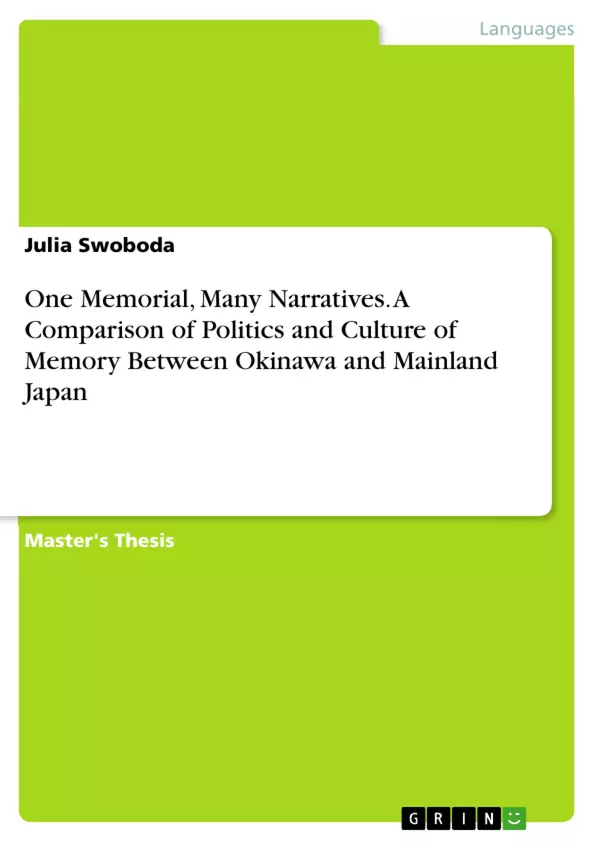The work present aims, by means of a comparative approach on the basis of the bilaterally contested narratives around the Himeyuri no Tō Memorial and Museum, to examine the predominant narratives about the HSC in Okinawa and Japan. After assessing the differences and possible overlapping areas of both narratives in consideration of the respective historical and socio-political contexts in which they developed, the next step will lead from description to analysis of current processes of politics of memory and identity. One particular interest is the question as to how the HSC narrative is utilized in Okinawan and mainland politics of memory and identity since 1945. Another question concerns the influence of Okinawa's politics of identity on Japan: How has the wartime past been depicted so far, and what are the bilateral claims to memory and its representation in the public sphere? Finally, to what extent is Okinawa able to influence the mainland's view of history, and what implications does this have for the possibility of and limits to both an Okinawan-Japanese identity, and a conceptual shift towards a broader understanding of “Japaneseness”?
Inhaltsverzeichnis (Table of Contents)
- Introduction
- The History of the Himeyuri Student Corps, Memorial and Museum.
- Education in Okinawa since 1879 and the Himeyuri Girls as the New Elite
- The Himeyuri Student Corps in the Battle of Okinawa
- The Himeyuri no Tō Memorial and Museum
- Okinawan and Japanese Narratives on the Himeyuri Corps in the Battle of Okinawa and the Reception of the Memorial and Museum...
- The Okinawan Narrative.
- Translation of Selected Survivors' Testimonials...
- The Okinawan Narrative in Social and Academic Discourse......
- Translation: Mikame Tatsuji's “Himeyuri no Tō“.
- Predominant Japanese Narratives......
- The Japanese Narrative in Social and Academic Discourse.
- Analysis: (Re-) Construction of History as Re-negotiation of Okinawan and Japanese Identity ..
- Identity Politics and Discourses on War Memory since 1945: Distinct Courses
- Okinawa: Okinawa no Kokoro and the Role of Women in the Representation of Okinawan War Memory and Pacifist Movements......
- Japan: Victims for the Nation - Rehabilitation of Military and State through the Glorification of Voluntary Sacrifice......
- Bilateral Claims to Public Memory and the Depiction of History.
- Japanese Claims toward Okinawa Concerning the Depiction of History around the Himeyuri Memorial and Museum
- Okinawan Resistance to the Japanese Appropriation of the Narratives around the Battle of Okinawa and the Himeyuri Nurse Corps .........
- Implications for the Forming of Identities and Current Inner-Japanese Processes..
- Processes and Limitations towards an Okinawan-Japanese Identity.
- Conceptual Shifts within the Japanese Society and the Need to Rethink "Japaneseness".
- Conclusion and Outlook
Zielsetzung und Themenschwerpunkte (Objectives and Key Themes)
This thesis examines the different interpretations of the Himeyuri Student Corps and its memorial in Okinawa and mainland Japan, exploring the complex relationship between politics and culture of memory. It aims to understand how historical narratives are constructed and contested in relation to national identity and the shared history of war.
- The history and significance of the Himeyuri Student Corps in the Battle of Okinawa
- The role of the Himeyuri no Tō Memorial and Museum in shaping memory and identity
- The contrasting narratives surrounding the Himeyuri Corps in Okinawa and mainland Japan
- The interplay between politics, culture, and memory in constructing national identities
- The implications of these different narratives for present-day Japanese society
Zusammenfassung der Kapitel (Chapter Summaries)
The thesis begins by tracing the history of the Himeyuri Student Corps, their role in the Battle of Okinawa, and the establishment of the Himeyuri no Tō Memorial and Museum. Chapter 2 examines the educational context in Okinawa since 1879 and how the Himeyuri girls represented a new elite. The chapter also delves into the student corps' experiences in the Battle of Okinawa and the subsequent construction of the memorial and museum.
Chapter 3 delves into the contrasting Okinawan and Japanese narratives surrounding the Himeyuri Corps and the memorial. The chapter explores the diverse perspectives of survivors and analyzes key social and academic discourse within both Okinawa and mainland Japan.
Chapter 4 examines the complex relationship between history, memory, and national identity, focusing on the distinct ways in which Okinawa and Japan have constructed their narratives about the war. The chapter analyzes how the Himeyuri memorial and museum have become a site of negotiation and contestation over historical memory, identity, and political power.
Schlüsselwörter (Keywords)
This study examines the interconnected themes of war memory, national identity, gender, and politics, focusing on the Himeyuri Student Corps, the Battle of Okinawa, and the Himeyuri no Tō Memorial and Museum. Key concepts include the construction and contestation of historical narratives, the influence of memory on national identities, and the relationship between politics and culture of memory in shaping public discourse.
- Arbeit zitieren
- Julia Swoboda (Autor:in), 2017, One Memorial, Many Narratives. A Comparison of Politics and Culture of Memory Between Okinawa and Mainland Japan, München, GRIN Verlag, https://www.grin.com/document/455779



